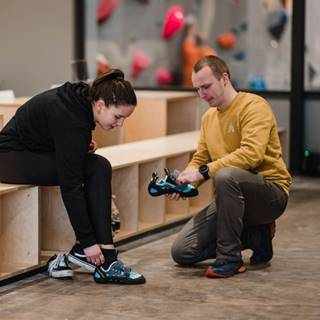‘How do I find the right climbing shoes?’
The painful shoes = well-fitting shoes myth is persistent in climbing. It’s also the reason why we all have a pair of rock boots stashed away in our wardrobes that make our feet wince at the mere thought of them, let alone when we ambitiously try to squeeze them on.
There are a few things that we regret about these shoes: they do nothing for our technique (to which precise footwork is key), they cost more than we’d care to admit, and worst of all they make us feel like we’ve failed somehow. (We haven’t!)
So just get a bigger size, right? After all, comfort trumps fashion...
Although you want to avoid foot-crushingly tight climbing shoes, oversized shoes have their downsides too.
As you progress through the grades and the footholds begin to shrink or disappear altogether, trusting your feet to stay in place becomes increasingly important. Any unoccupied space in your shoes reduces grip and sensitivity – your ability to feel the footholds – so you’re more likely to slip off the foothold when you’re least expecting it. This unoccupied space will also make your shoes wear out quicker.
So what we’re looking for is a snug fit, but not too snug.
Just to add to the confusion, climbing shoes change shape and stretch as you break them in, so they’ll be floppier after a few weeks of wear (especially leather). Your feet also fluctuate in size from hour to hour and one of them may well be bigger than the other. It just feels like the odds are stacked against you...
Don’t worry! We’ve all been there which means you’ll get a lot of advice from fellow climbers on this matter. Take any advice on board but remember that everyone’s feet are different, listen to your own feet above anyone else, they know what they like better than anyone!
At The Hangar, we offer a free expert shoe fitting with our crew where you can test out different shoes on our climbing wall to ensure they feel comfortable and secure with no obligation. We'll provide you with all the guidance and support you need to make an informed decision and find the perfect shoe for you.
Here are a few pointers to get you on the right tracks:
Rules to live by:
- Listen to your feet!
- Your shoes shoe be relatively tight or snug when you first get them, but not painful (you’re meant to be enjoying yourself).
- Your shoes will stretch with wear, but how much they will stretch depends on the brand, model and materials – do some research online for an idea of how much they will stretch. (Leather expands more than synthetic).
- Try loads of difference shoe brands: different brands cater to different foot shapes.
- It will be tricky to get your shoes on at first, bear with them!
Think about your foot shape:
- How wide are your feet? If you have narrow feet consider trying low volume (LV) models.
- What shape are your toes?
- How long will you be wearing them for – all day training shoes can afford to be less snug than those projecting shoes that you’ll be whipping off between attempts.
Assessing the fit:
Once on, look at the following areas of your shoe for fit (or test them out)
- Toebox – all of your toes should be right in the end of the toe box, with no dead space.
- Heel – this should be snug and secure; you don’t want your shoe to come off on the crucial heel hook!
- Sides – your shoe should be snug around the side of your foot too. If your toes are in the toebox and the shoe is still baggy, consider a lower volume shoe.
Too big or too small?
Your shoes are too big when:
- There's gap between the heel and the opening of the shoe
- The material is bunching
- Your foot can move around inside
- The material’s bunching.
Your shoes are too small when:
- It’s too painful to put them on!
Expert Shoe Fitting Service
Looking for the perfect fit for your climbing shoes? Look no further than our FREE professional climbing shoe fitting session!
Our friendly, expert crew will work with you to determine the perfect fit for your feet.

